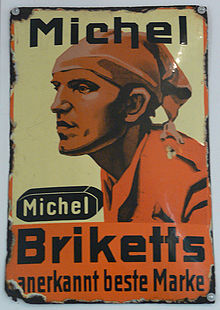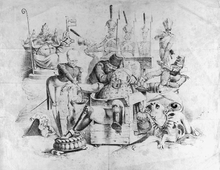German Michel
The German Michel is probably a national personification of the Germans that originated as early as the Renaissance and is now almost only used in caricatures .
presentation

Its most striking attribute is its sleeping cap or pointed cap . The earliest pictorial representations of Michel date back to the first half of the 19th century . Its figurative form refers to literary precursors or a popular understanding of the figure. The Michel reached the peak of its popularity in the 1840s .
The character's characteristics and essence remain a political issue to this day. The view that the Michel goes back to the Archangel Michael ( patron saint of Germany since the battle on the Lechfeld in 955) or the equestrian general Hans Michael Elias von Obentraut is widespread to this day. There is no valid evidence for either claim. With regard to the influences of the figure of Saint Michael, there are at least interesting hypotheses (keyword: pilgrimages to Mont-Saint-Michel or the role of the patron saint in the Christianization of northern Germany). The earliest documented tradition can be found in a dictionary of proverbs published by Sebastian Franck in 1541 - a few decades before Obentraut was born. The German Michel describes a fool, a booby and a fanatic. A similar understanding can be found in other contemporary sources.
In 1910 the Michelbrunnen was built in Bad Liebenwerda .
Origin of the phrase
In science today, the general view has become that the phrase “a German Michel” is a birth of the Renaissance . The humanism in Germany had the latin elected language. This created a gap between the language of education and that of the people. This led to a spiritual culture that sought connection to foreign countries. In this context, the phrase of the “German Michel” probably arose from an interplay of foreign stereotypes of the Renaissance of the exhausting, boozy and sleepy Germans with the equally negative German peasant image of the late Middle Ages .
Contrary to the earliest, purely pejorative uses, the figure - simple, uneducated and ignorant of foreign languages - became a cultural emancipatory symbol of a pure, German mother tongue during the Thirty Years' War - for example with Hans Jakob Christoffel von Grimmelshausen . The term was mobilized as early as 1630 in the fight against foreign words , as the title of a satirical leaflet, Teutscher Michel , which is one of the strangest manifestations of German linguistic purism : Ich teutscher Michel / Versteh schier nichel / In my Vatterland / It's a shame . In the middle of the 18th century , Gottlieb Wilhelm Rabener used the term to lament the general disdain for German poetry. At the same time, the figure of "Cousin Michel" gained popularity. The characteristics attributed to her were cosiness, honesty and a private and public need for rest. Various interpretations can be found in humorous periodicals and in literature from the first half of the 19th century.
The Michel in March
The most common are undoubtedly depictions of Michel alluding to the naive peasant boy or the easy-going honest man. In Joseph Eiselein's dictionary of German proverbs and meaningful speeches from 1840, the term denotes “the entire heavy German people”; the General German Real Encyclopedia of 1846 sees in Michel the personification of the "follies and perversions" of the German nation. Basically the figure at this time is already the collective symbol for the German people or their nature in today's sense.
Like some of his contemporaries, Ernst Moritz Arndt tried to transfer the traditional picture of Michel into a new context of tradition. From the assumption that there is a synonymous relationship between the Michel term and the German mentality, he concluded that the properties of the Michel depend on the political conditions and historical development, which was absolutely correct for the Michel images of his era. His subsequent, mythologically transfigured and polemic return of the characteristics of the Michel to the type of a medieval fortified farmer strains the etymology of the German Michel far too much. Similar misleading approaches, such as speculation about the equestrian general Obentraut as the namesake, are still widespread - although they have been refuted in science for over a hundred years - to this day.
Comedy by Fritz Stavenhagen and the resulting radio plays
In 1905 Fritz Stavenhagen wrote his Low German peasant comedy De dütsche Michel , which consists of five acts.
The comedy is tailored to the figure of the eternal German Michel, who is stuck in the peasant tower. He denies the living, like here a count and a poet, everything they could ask for, while he is ready to give everything to the dead.
In 1951 Albert Mähl edited the piece for radio, which was produced as a dialect radio play by the NWDR Hamburg and first broadcast on September 18, 1951. Numerous ensemble members of the Ohnsorg Theater spoke under the direction of Hans Freundt , including:
- Erwin Wirschaz : Count Malling
- Hartwig Sievers : Baron von Oertzen
- Heidi Kabel : Hanna, his daughter
- Georg Pahl : Lüdering
- Hans Mahler : Mattens
- Rudolf Beiswanger : Maak
- Heini Kaufeld : Jörn
- Walter Scherau : Köster
- Otto Lüthje : Werner
- Walther Bullerdiek : Panschow, landlord
- Heinz Piper : from Plessen
- Heinz Lanker : from Maltzahn
- Hilde Sicks : Ivenak, daughter of von Plessen
- Ludwig Meybert : A sick beggar
In 1956, Radio Bremen also accepted the template. Eberhard Freudenberg took over the radio processing and directed it. It was first broadcast on September 15, 1956. The following spoke:
- Hanns Lothar : Johann Graf Malling
- Paul Cruse : Baron von Örtzen
- Heinz Burmeister : Lüdering, farmer
- Heinrich Kunst : Mattens, farmer
- Heinz Beusen : Maak, farmer
- Jochen Schenck : Jörn, farmer
- Carl Hinrichs : Köster, farmer
- Ivo Braak : Rodemann, farmer
- Ernst Waldau : Panschow, landlord
- Walter Jokisch : From Maltzahn
- Else Hackenberg : Ivenak
- Hermann Menschel : Büttel Pommerenk
Also in 1956, Albert Mähl wrote the radio play:
- Fritz Stavenhagen. An audio series about the work and life of the first Low German playwright of recent times on the 50th anniversary of his death on May 9, 1956 with samples from Der Lotse , Mudder Mews and De dütsche Michel
In this NDR production directed by Hans Tügel, among others, Heinz Klevenow as Count Malin, Walter Klam as Von Maltzahn and Hilde Sicks as Ivanak, daughter of Plessens.
See also
literature
- Manfred Escherig: Michel's hats and freedom. Excess mythological considerations on some emblems of the revolution. (In: Michels Erwachen - Emanzipation durch Aufstand? Ed. By Michael Knieriem . Wuppertal 1998, pages 294-325.) ISBN 3-87707-526-6 .
- Bernd Grote: The German Michel. A contribution to the journalistic importance of the national figures (= Dortmund contributions to newspaper research. Vol. 11, ISSN 0417-9994 ). Ruhfus, Dortmund 1967 (at the same time: Berlin, Free University, dissertation of February 7, 1966).
- Karl Riha : The German Michel. For the expression of a national allegory in the 19th century. In: Jürgen Link , Wulf Wülfing (Ed.): National myths and symbols in the second half of the 19th century. Structures and functions of concepts of national identity (= language and history. Vol. 16). Klett-Cotta, Stuttgart 1991, ISBN 3-608-91062-X , pp. 146-171.
- Tomasz Szarota : The German Michel. The history of a national symbol and car stereotype (= Klio in Poland. Vol. 3, ZDB -ID 1455144-5 ). Edition Fiber, Osnabrück 1998, ISBN 3-929759-38-1 (also: Warsaw, Univ., Habil.-Schr., 1988).
- Horst Heidermann : Seel. Johann Richard Seel, painter in Wuppertal and draftsman of the German Michel (= contributions to the history and local history of the Wuppertal. Vol. 40). Thales-Verlag, Essen 2003, ISBN 3-88908-492-3 .
Web links
- The German Michel in the March
- Where the German Michel died and where he was buried
- House of the story about the German Michel
- Short version of a text after Bernd Grote, edited by Norbert Saul 2007
Individual evidence
- ↑ Language heroes and language spoilers. Documents for research into foreign word purism in German (1478–1750) . Selected and commented on by William Jervis Jones. Walter de Gruyter, Berlin, New York, 1995. ISBN 3-11-014480-8 . Pages 138-160.
- ^ ARD audio game database (De dütsche Michel, NWDR Hamburg 1951)


